This article is part of our Collette Calls series.
Writing during this time of uncertainty has been a challenge. I certainly have more time on my hands than I normally do with a partial furlough at work, but material during this time has been tough to come by as I had mostly exhausted my offseason bucket of ideas. Given that we never got to tie a bow on the potential new pitches of 2020, I am going to look back at one of the top graduates of the 2019 New Pitch program: Frankie Montas.
Montas entered the 2019 season as a high-octane arm who was already out of minor league options despite working just 112 major league innings from 2015-2018 around a rib resection surgery that caused him to miss most of the 2016 season. Statistically, Montas looked like this entering the 2019 season:
| Stat | Performance |
|---|---|
| ERA | 4.90 |
| WHIP | 1.58 |
| K% | 20.0 |
| BB% | 10.0 |
| HR/9 | 1.3 |
| BA | .288 |
| wOBA | .360 |
The overall picture was bad, but the splits were even worse. Montas was a three-pitch pitcher coming into the season: using both a two- and four-seam fastball and a slider. The fastball had a lot of velocity, but the command was inconsistent, but the slider was good. Still, he threw his fastballs 70 percent of the time in a league that loves to hunt fastballs.
| Stat | Performance vs RHB | Performance vs LHB |
|---|---|---|
| ERA | 3.47 |
Writing during this time of uncertainty has been a challenge. I certainly have more time on my hands than I normally do with a partial furlough at work, but material during this time has been tough to come by as I had mostly exhausted my offseason bucket of ideas. Given that we never got to tie a bow on the potential new pitches of 2020, I am going to look back at one of the top graduates of the 2019 New Pitch program: Frankie Montas.
Montas entered the 2019 season as a high-octane arm who was already out of minor league options despite working just 112 major league innings from 2015-2018 around a rib resection surgery that caused him to miss most of the 2016 season. Statistically, Montas looked like this entering the 2019 season:
| Stat | Performance |
|---|---|
| ERA | 4.90 |
| WHIP | 1.58 |
| K% | 20.0 |
| BB% | 10.0 |
| HR/9 | 1.3 |
| BA | .288 |
| wOBA | .360 |
The overall picture was bad, but the splits were even worse. Montas was a three-pitch pitcher coming into the season: using both a two- and four-seam fastball and a slider. The fastball had a lot of velocity, but the command was inconsistent, but the slider was good. Still, he threw his fastballs 70 percent of the time in a league that loves to hunt fastballs.
| Stat | Performance vs RHB | Performance vs LHB |
|---|---|---|
| ERA | 3.47 | 6.70 |
| WHIP | 1.32 | 1.91 |
| K% | 25.0 | 14.0 |
| BB% | 8.0 | 13.0 |
| HR/9 | 0.7 | 2.0 |
| BA | .262 | .319 |
| wOBA | .307 | .418 |
His numbers were rather effective against righties with the sinker/slider approach, but lefties feasted off him when Montas was given the opportunity to face them (237 times). Montas clearly needed something against lefties if he was going to become a starting pitcher and avoid the well-formed mold of a righty with a big fastball and slider who is used in middle relief work until he finds command and can work in high leverage. Simply put, he was unusable against lefties in most game situations given every pitch he threw a lefty was nearly as likely to become a non-strike as it was to generate any form of a strike in the count:

Montas's approach against lefties was incredibly fastball heavy as he tried to work up and down with the pitch while looking to throw his slider under the swing of lefties or attempt to backdoor it. He mostly threw his changeup when he was ahead in the count, but the pitch disappeared once the count went to three balls:
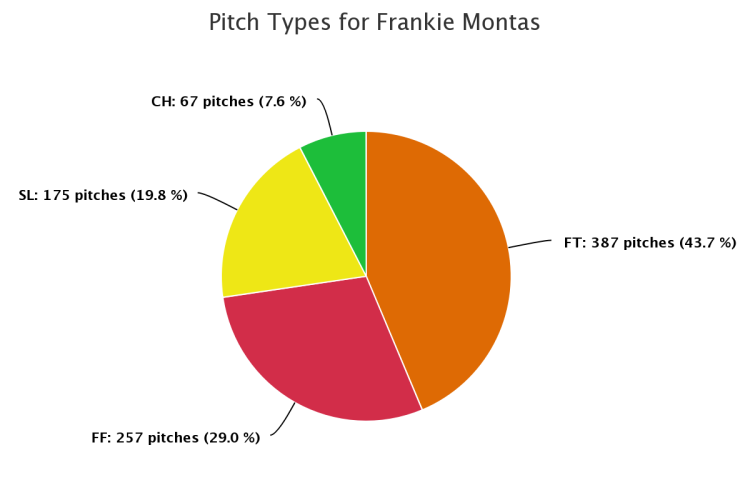
It is worth reminding that the league loves hunting for fastballs, and yet here was Montas throwing fastballs 73 percent of the time to lefties, and mostly of the two-seam variety, which is not a good generator of swings and misses. That, plus a majority of his pitches to lefties were living in the middle of the zone or up in the strike zone for hitters to pounce on:
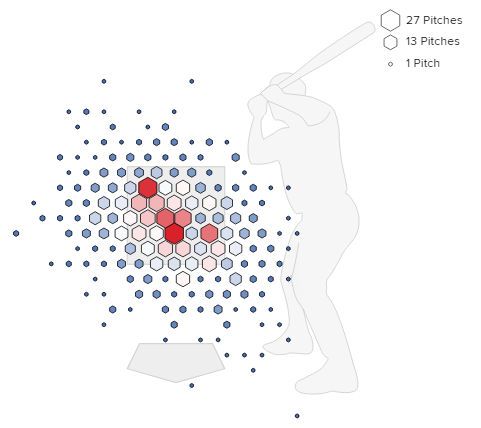
There was clearly a need for an effective third pitch for Montas to use against lefties, one which could generate some much needed swings and misses and give him something off-speed to compliment the hard fastball and slider combination. Enter the splitter.
Montas had been playing with the pitch before the 2018 season, but was not yet comfortable enough with the pitch to use it as a go-to weapon as he did in 2019. That season, being out of options and wanting to avoid the bullpen, presented the conditions necessary to give Montas the confidence of trying out the new pitch. The results, before his suspension essentially ended his season, were dramatic:
| Stat | Performance vs LHB 2019 | Performance vs LHB 2015-2018 |
|---|---|---|
| TBF | 212 | 237 |
| ERA | 2.66 | 6.70 |
| WHIP | 1.14 | 1.91 |
| K% | 29.0 | 14.0 |
| BB% | 6.0 | 13.0 |
| HR/9 | 0.7 | 2.0 |
| BA | .231 | .319 |
| wOBA | .274 | .418 |
He doubled his strikeout rate, halved his walk rate, became less hittable, and showed that he was more than just a low-leverage middle reliever with troublesome command. The dramatic turnaround was something to watch, especially for owners who took a very late flyer on him in the deepest of drafts. One might assume that because his statistics were significantly different, his pitch breakdown must also have changed dramatically, but that is not the case:
Alex Fast had a great article last year on a metric CSW - called strikes + whiffs. The article was the 2019 FSWA baseball research piece of the year, so you should check it out. The formula is simple: called strikes + whiffs divided by total pitches. Montas's CSW from 2015-2018 was 22 percent against lefties, and that jumped to 30 percent in 2019. That is a noticeable improvement, mostly a result of him improving his whiff (swinging strike) rate by six full percentage points as hie had but a modest gain in his called strike rate.
His pitch mixture against lefties had a much more noticeable change to it in that the splitter replaced the show-me changeup, and was utilized nearly 400 percent more often than he used said changeup:
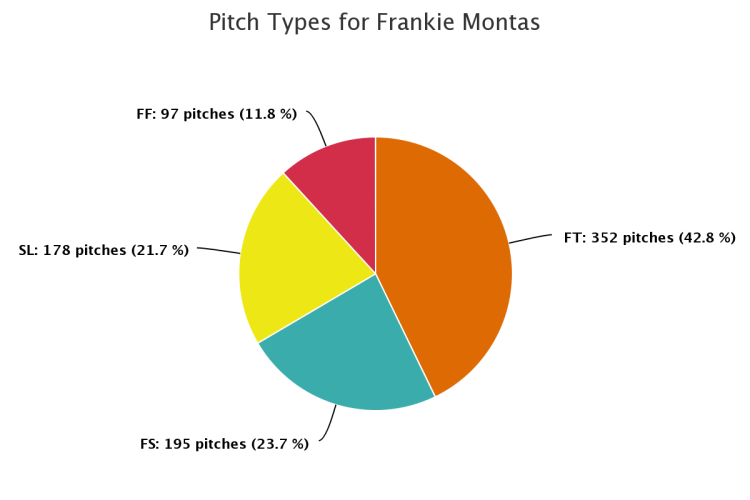
The fastballs and slider utilization was not much different, but the effective splitter gave him a change of speed pitch as well as an ability to work other areas in and around the zone to lefties:
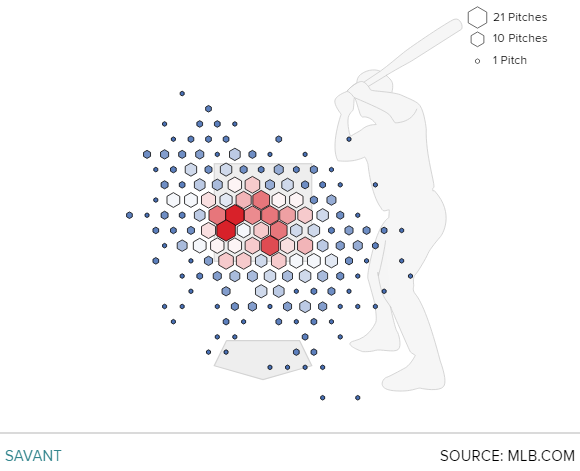
How confident was Montas in that splitter? He threw it in every count except a 3-0 count in 2019, which helped his overall whiffiness against lefties he sorely lacked in previous years.
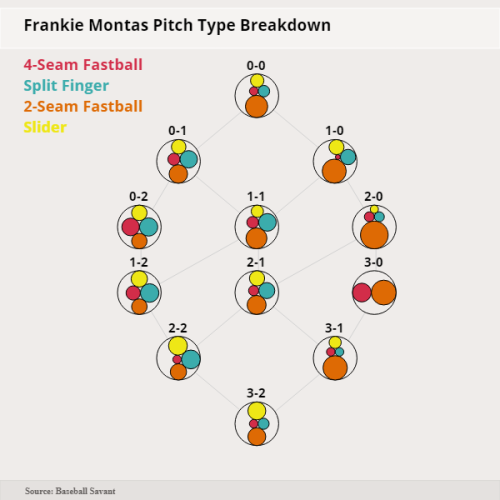
Old Montas never threw his previous off-speed pitch in a three-ball count and the changeup, and he threw the pitch just three percent of the time when he was behind the hitter at any point in the count during a plate appearance. The heavy fastball/slider approach when he fell behind to lefties led to the league posting a .480 wOBA on pitches when Montas was down in the count. Last season, the splitter was utilized 18 percent when Montas was down in the count, and it was his four-seamer which had the lowest utilization (8 percent). That approach helped him reduce his wOBA on pitches in those situations by 70 points.
An amazing stat for Montas is the fact that he struggled with success previous to 2019. Montas could use his hard stuff to get ahead in the count, but then lacked the approach and overall repertoire to put guys away. In fact, lefties had a .375 batting average and a .392 wOBA on pitches Montas threw when he was AHEAD in the count. He threw a rather equally distributed assortment of pitches, but the outcomes were horrendous:
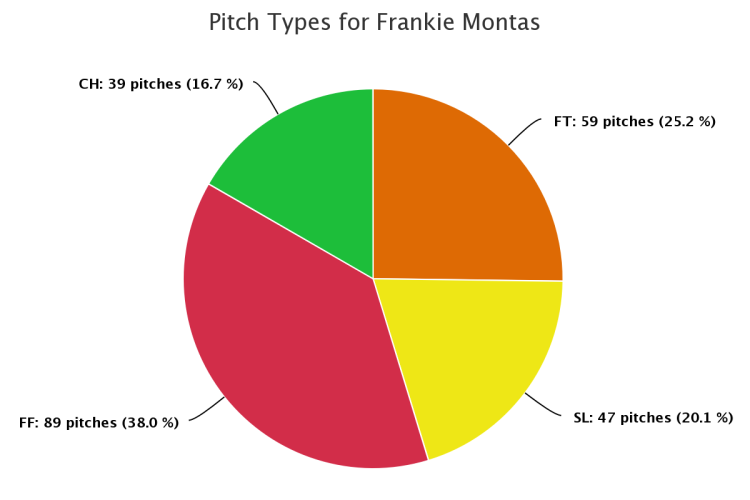
2019 was the exact opposite for the young hurler as opposing lefties hit just .130 off him with a .132 wOBA on pitches thrown to them when Montas had the high ground. He was Obi-Wan Kenobi, and the hitters were burning down like Anakin Skywalker. Again, one might assume the success came from leaning on the new splitter, but in fact, just its mere presence gave hitters something else to think about. That, and cutting way back on utilizing his somewhat flat four-seamer:

Montas made significant steps forward last year adding his splitter, which changed his role from middle reliever to a front of the rotation starter. The PED suspension brought a screeching halt to his growth, and we only saw one more outing from him before the season ended. The new pitch was important for a couple reasons: it gave him an effective off-speed pitch that then had hitters thinking about four different offerings coming to the plate with multiple velocities and multiple movements. It made him less predictable and allowed him to take full advantage of the talents which initially got him a nice signing bonus from Boston, traded to Chicago as part of a deal for Jake Peavy, then dealt to Los Angeles as part of the Todd Frazier deal and finally to Oakland as part of the deal for Josh Reddick and Rich Hill. He always had the talent, but it was ironically a split that brought it all together.










